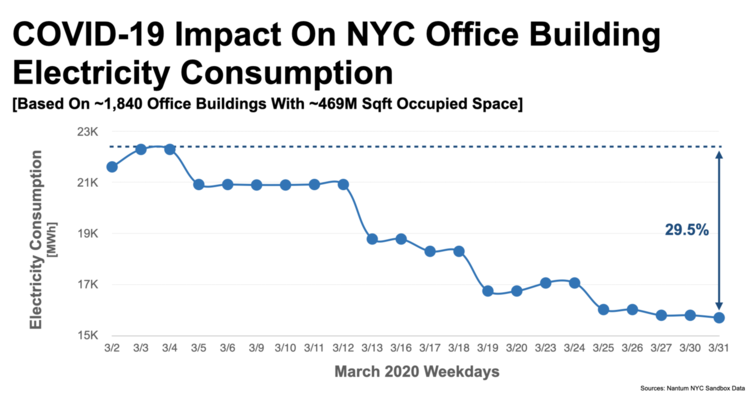The Impact Of COVID-19 On NYC Office Buildings
Office Building Occupancy, Energy Consumption, and Carbon Footprint
The battle against COVID-19 has put property owners and managers to the test. Tasked with continuing operations for essential employees while implementing government-mandated social distancing policies, many in the world of commercial real estate are left wondering how these unprecedented times will impact their customers and future business operations.
Using Nantum AI’s real-time occupancy, energy monitoring, and carbon emission tracking from our 10 million square foot NYC sample set, combined with data from the New York City Mayor’s Office of Sustainability, the Nantum AI research team was able to illustrate the impact Governor Cuomo’s Stay-at-Home orders had on the city’s office building landscape. The Nantum AI team is dedicated to providing health officials with real-time information to support both policy decision making and policy impact analysis during this time of crisis.
OCCUPANCY
Using Occupancy To Track Employees Working From Home
Stay-at-Home orders have had a dramatic impact on office occupancy, as this chart illustrates. A sharp decline in office occupancy is mirrored by a sharp increase in confirmed COVID-19 cases in New York City. Though the State of New York did not officially implement a Stay-At-Home order until March 20, it’s clear office workers were already remaining at home, with occupancy rates beginning to plummet as early as March 10. Using data provided by the NYC Mayor’s Office of Sustainability, Nantum AI extrapolated a sample set of its own data to apply to all of New York City’s roughly 1,840 office buildings. At the start of the month, an estimated 1.4 million workers occupied 469 million square feet as tracked by the Mayor’s Office of Sustainability. By March 24, occupancy had fallen to roughly 41,000 essential building workers, a dramatically responsive 96%+ decrease.
This type of real-time occupancy insight is crucial during a time of crisis. Instead of waiting for tenant communication, smart buildings wired with occupancy sensors can track occupancy fluctuations in real-time and from day-to-day. Having real-time occupancy allows property owners and managers to know which buildings are still occupied, allowing informed decisions on where to deploy staff, services, and resources. As NYC begins the planning process to reopen, these same occupancy sensing capabilities will help track which buildings are filling back up as employees begin to come back to work. In parallel, building operators will be able to ensure that the right staff is at the right place at the right time, guaranteeing the safety, security, and comfort that commercial office tenants have come to expect.
ENERGY
COVID-19 Reduced NYC Office Building Energy Consumption By An Estimated 29.5%
Nantum AI’s insights also shined light on energy consumption in unoccupied buildings. While occupancy may have declined sharply, energy consumption has only moderately declined. Our research team saw energy consumption decline by 29.5% across our NYC sample set. While those energy consumption reductions are a welcome silver lining, they don’t match the magnitude of decrease in occupancy.
So, why hasn’t energy consumption decreased more dramatically? Because office owners and managers have continued to manage their buildings with essential workers, including building operations, security, and engineers in order to guarantee property safety and tenant SLAs. Service Level Agreements (SLA) between property owners and tenants keep buildings operating at a basic level regardless of the occupancy level. While some lease obligations allow for conditions to downgrade from “perfect” to “acceptable”, maintaining acceptable levels still requires high levels of energy consumption. Workers may not be physically occupying their office space, but computers and servers are still running, being accessed remotely. We found that most of the energy savings across our test portfolio came from decreases in ventilation and HVAC system usage.
CARBON EMISSIONS
COVID-19 Reduced NYC Office Building Carbon Emissions By An Estimated 30.9%
A 29.5% reduction in energy usage is mirrored in this chart, showing a roughly 30% reduction in greenhouse gas emissions. Given the relatively cold temperatures of March, more energy on average was used across our sample set of buildings, despite the drop in occupancy. Why? Because building systems, normally accustomed to the presence of human-generated ambient heat, had to overcompensate for the absence of body heat in heating common areas and tenant spaces. With gas and steam doing most of the heating and accounting for most a building’s emissions, a decrease in occupancy has not led to the same decrease in emissions.
When the crisis is over, changes to Service Level Agreements may be one of its lasting impacts on the commercial real estate industry. As the data suggests, energy consumption on average remained high relative to average building occupancy despite Stay-at-Home directives. Allowing property owners and managers to adjust energy usage and climate levels during times of crisis could reduce energy consumption, which in turn would lead to sharp reductions in greenhouse gas emissions. Inflexible SLAs are needlessly contributing to greenhouse gas emissions as property managers waste energy on heating and cooling spaces — spaces that are unoccupied — just to meet lease obligations.
METHODOLOGY
Our approximation of daily occupancy in NYC office buildings is illustrated by the formulation above.
Our approximation of daily electricity consumption in NYC office buildings is illustrated by the formulation above.
Our approximation of carbon emissions created by NYC office buildings is illustrated by the formulation above.
NANTUM SANDBOX
HTTPS://WWW.PRESCRIPTIVEDATA.IO/PARTNERS/RUDIN-SANDBOX
NYC DEPARTMENT OF HEALTH AND MENTAL HYGIENE
HTTPS://WWW1.NYC.GOV/SITE/DOH/COVID/COVID-19-DATA.PAGE
(VISITED ON APRIL 1, 2020)
THE MAYOR'S OFFICE OF SUSTAINABILITY
HTTPS://WWW1.NYC.GOV/HTML/GBEE/HTML/PLAN/LL84_SCORES.SHTML
(2018 ENERGY AND WATER DATA DISCLOSURE, VISITED ON VISITED ON APRIL 1, 2020)
More Case Studies











